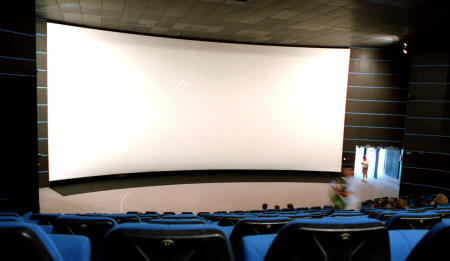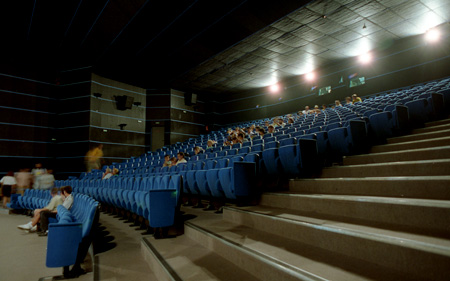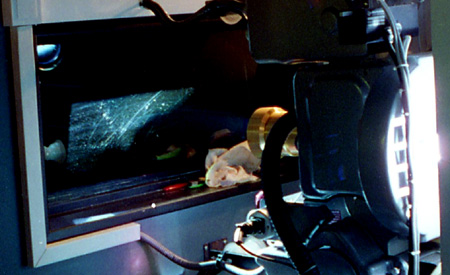My Showscan Story |
Read more at in70mm.com The 70mm Newsletter |
| Written by: Thomas Hauerslev | Date: 26.06.2011 |
 Showscan
cinema in "Les Pavillons de la Communication et de la Créativité" Poitiers,
France, 1992. Note the size of this "free floating" screen compared to the
person at the entrance. Image by Thomas Hauerslev Showscan
cinema in "Les Pavillons de la Communication et de la Créativité" Poitiers,
France, 1992. Note the size of this "free floating" screen compared to the
person at the entrance. Image by Thomas HauerslevClick the image to see enlargement My first encounter with the work of Mr. Douglas Trumbull dates back to the Danish 1978 70mm premiere of “Close Encounters of the Third Kind”. In the souvenir program Mr. Trumbull was presented as the special effects supervisor. I had also recently seen "2001: A Space Odyssey" too, (in 70mm of course) and realised Mr Trumbull's association with that film as well. As time progressed I gradually learned more about this new process; Showscan, which Mr. Trumbull was developing. I continued to look for information about Showscan in the following years. But in pre-historic time BTI (before the internet), information was not easy to get. Slowly, v-e-r-y slowly, I got the basic idea, and while being only a teenager, however, I was intrigued by three things about it. - 65mm running at 60 frames pr. second - The concept of High Impact Theatres with big curved screens - Showscan films didn't need to be longer than 30-45 minutes. Showscan films presented like this would create a sensation so intense at 60 frames pr. second, that it would be enough for the spectator to feel completely engulfed in the images - what a provocative idea. A whole new movie language. |
More in 70mm reading: Showscan Showscan Speciality Theatre Films and Ride Films "New Magic" in 70mm Showscan The Impact of Showscan - Experienced by in70mm.com readers Showscan: The Future is Now - The Future of Feature Film Exhibition Showscan: A High Impact Experience in 70mm Showscan enters liquidation process |
 Showscan
cinema "Les Pavillons de la Communication et de la Créativité" in Poitiers,
France, 1992. Image by Thomas Hauerslev Showscan
cinema "Les Pavillons de la Communication et de la Créativité" in Poitiers,
France, 1992. Image by Thomas HauerslevDuring the 1980s I kept looking in trade magazines like Variety and newspapers, and slowly built up a collection of articles - not an impressive collection, but at least it was something. In 1988 the 25-screen Kinepolis in Bruxelles opened with great fanfare. All 25 wall-to-wall screens were curved and built to Showscan specifications. The smallest screen was 12 meters wide, and 7 auditoriums had 70mm equipment installed, plus one or two for Showscan and one for IMAX. I had to see that and went there in 1989 only to find out, that Showscan wasn't shown any more. Bummer! A couple of years later in 1992, my wife and I travelled all the way to Poitiers in the south-west of France to see Showscan. On that July day I finally had my only-ever encounter with Showscan and REAL PICTURE QUALITY. |
|
 Showscan
projector in Poitiers, France, 1992. Image by Thomas Hauerslev Showscan
projector in Poitiers, France, 1992. Image by Thomas HauerslevWe saw "New Magic" in 70mm at 60 frames per second in their purpose built Showscan theatre. It was simply fantastic, and I shall never forget it. I cannot remember much about the film itself, but the visual impact of Showscan hit me right in the face. From then on, ordinary cinema just seemed like "old school" to me. I have never seen anything like this since, or before for that matter, which even remotely compares to the quality of Showscan. Todd-AO at 30 frames comes close, but yet, NOTHING like Showscan. The sharpness and crispness was simply astonishing. This is what movies should be like! It was so sharp that it was almost unreal, maybe even surreal for a cinema. This looked like real life, and not a film in a cinema. I remember some Hollywood executive being quoted saying "It looks too good, it's a distraction". Thanks to the high frame rate and the large 65mm negative, there was no image blur during fast camera pans, and there was no wagon-wheel strobe effect (wheels running backwards on screen) on rotating objects. Just like real life, everything looked like, well, real life. After seeing all this I have always found it amusing that animated movies have "motion blur" incorporated to make it look like film. |
|
 Century
70mm projector adapted for Showscan. "Les Pavillons de la Communication
et de la Créativité" in Poitiers in France, 1992. Image by Thomas
Hauerslev Century
70mm projector adapted for Showscan. "Les Pavillons de la Communication
et de la Créativité" in Poitiers in France, 1992. Image by Thomas
HauerslevOne curious thing was the fluid "video-like" quality of the image. But I guess, when the frame rate is that high, our eye starts seeing things differently. It was like seeing a whole new language for cinema presentation being written, and I'm sure Mr. Trumbull anticipated that when he envisioned this process. Many years have passed since 1992, and since I started editing The 70mm Newsletter / in70mm.com web site, I always wanted to present Showscan properly to the readers. But having only seen one film, I felt my background wasn't sufficient to write anything that would do justice to Showscan. At Bradford, England, I have been fortunate to meet Mr. Richard Greenhalgh on a couple of occasions. Richard worked for Paramount Pictures during the early days of Showscan - AND - during one weak moment - Richard promised to write about it for in70mm.com one day. While we all wait for his manuscript, I have found a text which will explain the story of Showscan. I hope you enjoy it. Showscan: A High Impact Experience in 70mm Showscan: The Future is Now - The Future of Feature Film Exhibition |
|
|
Go: back - top -
back issues - news index Updated 22-01-25 |
